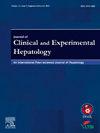Adopting Early Extubation in Pediatric Living Donor Liver Transplantation: A Focus on Feasibility and Safety of the Practice
IF 3.2
Q2 GASTROENTEROLOGY & HEPATOLOGY
Journal of Clinical and Experimental Hepatology
Pub Date : 2025-08-18
DOI:10.1016/j.jceh.2025.103153
引用次数: 0
Abstract
Background
Pediatric living donor liver transplant (LDLT) presents with its own unique challenges and requires considerable surgical and anesthetic expertise for a favorable outcome. One of the critical determinants of improved outcomes following liver transplantation is early extubation (EE). We conducted this study to determine our rate of EE and evaluate the predictive factors for successful EE in pediatric patients undergoing LDLT.
Methods
We performed a retrospective observational study and analyzed our data on pediatric patients (Aged 3 months to 10 years) who underwent LDLT from January 2022 to June 2024. Our primary objective was to evaluate the rate of EE after liver transplant in the pediatric population and demonstrate its safety across all ages. The secondary outcome was to determine predictive factors for successful EE in this population.
Results
A total of 28 patients were enrolled in the study and were divided into 2 groups: Early extubation (EE group (extubated on-table or ≤4 h postoperatively) and delayed extubation (DE) group (mechanically ventilated >4 h postoperatively). Out of 28 patients, 23 patients (82.1%) were successfully extubated on-table whereas 5 patients (17.9%) were included in the DE group. In our study, both the groups were comparable in demographic, preoperative, and intraoperative parameters except for age of children and duration of surgery, which were statistically significant between the groups.
Conclusion
Early extubation in pediatric patients is not only feasible but also a safe practice. Although, the retrospective nature of the study, small cohort, and exclusion of high-risk groups such as acute liver failure limit statistical power, the results are encouraging. Generalizability and validation of our clinical protocols warrant prospective studies with larger cohorts.

儿童活体肝移植早期拔管的可行性及安全性探讨
儿童活体供肝移植(LDLT)有其独特的挑战,需要大量的外科和麻醉专业知识才能获得良好的结果。肝移植术后预后改善的关键因素之一是早期拔管(EE)。我们进行了这项研究,以确定我们的情感表达率,并评估在接受LDLT的儿科患者中成功情感表达的预测因素。方法:我们对2022年1月至2024年6月接受LDLT治疗的儿童患者(3个月至10岁)进行了回顾性观察研究,并分析了我们的数据。我们的主要目的是评估儿童肝移植后EE的发生率,并证明其在所有年龄段的安全性。次要结果是确定该人群中情感表达成功的预测因素。结果共纳入28例患者,分为2组:早期拔管组(EE组,术后表上拔管或术后≤4 h)和延迟拔管组(DE组,术后机械通气+ 4 h)。在28例患者中,23例(82.1%)患者成功拔管,而DE组有5例(17.9%)患者。在我们的研究中,两组在人口统计学、术前和术中参数方面具有可比性,除了儿童年龄和手术时间,两组之间具有统计学意义。结论儿科患者早期拔管不仅可行而且安全。虽然,该研究的回顾性、小队列和排除急性肝衰竭等高危人群限制了统计效力,但结果令人鼓舞。我们临床方案的普遍性和有效性保证了更大队列的前瞻性研究。
本文章由计算机程序翻译,如有差异,请以英文原文为准。
求助全文
约1分钟内获得全文
求助全文
来源期刊

Journal of Clinical and Experimental Hepatology
GASTROENTEROLOGY & HEPATOLOGY-
CiteScore
4.90
自引率
16.70%
发文量
537
审稿时长
64 days
 求助内容:
求助内容: 应助结果提醒方式:
应助结果提醒方式:


